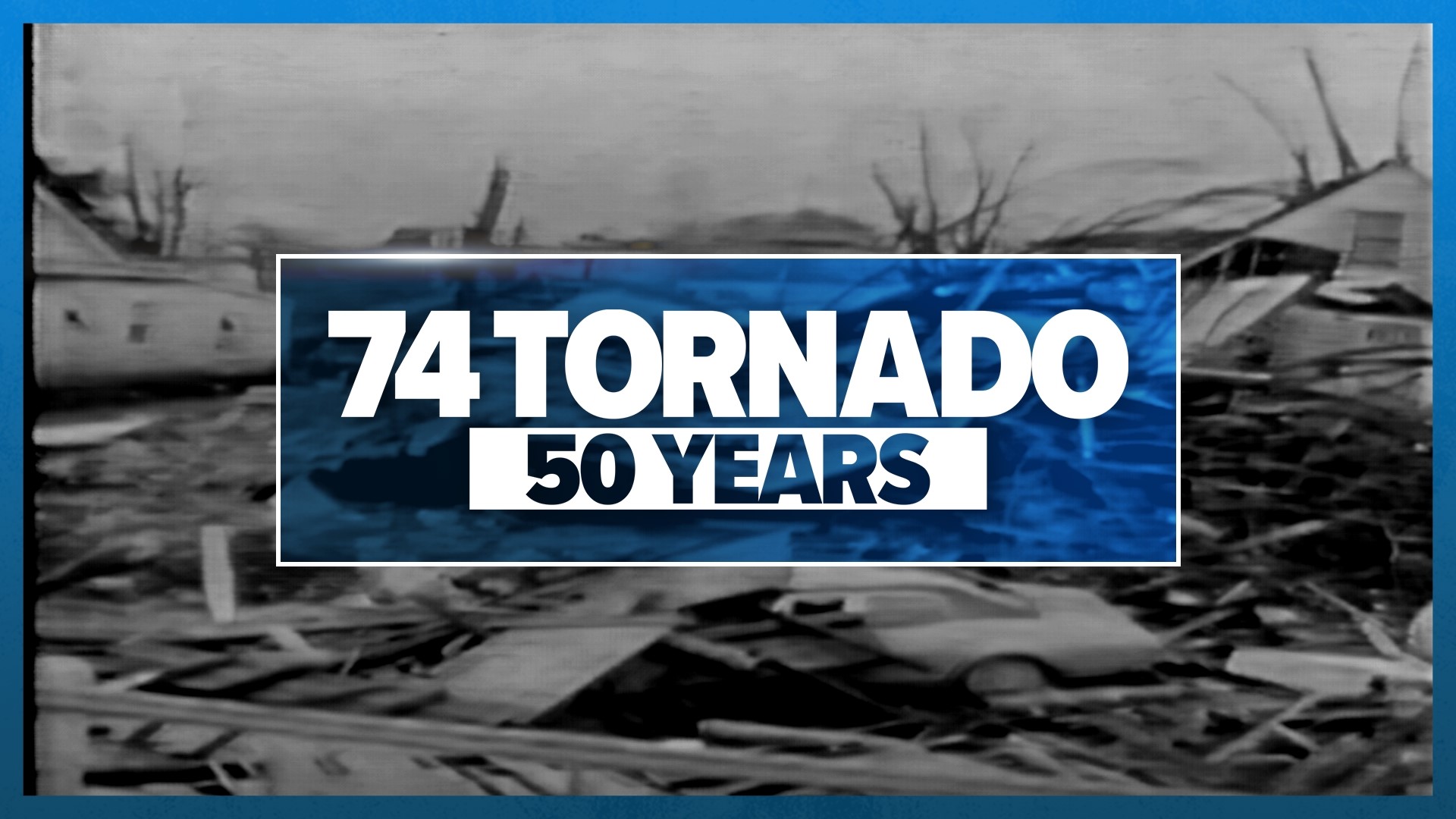LOUISVILLE, Ky. — The 1974 Super Tornado Outbreak is known as one of the worst tornado outbreaks in U.S. history — and the second largest tornado outbreak on record for a single 24-hour period.
This week marks 50 years since a series of destructive tornadoes struck across the Midwest, South, and East of the U.S., plus Ontario, Canada.
Within a 16-hour window, 148 tornadoes swept across the U.S. The states affected were Illinois, Indiana, Michigan, Ohio, Kentucky, Tennessee, Alabama, Mississippi, Georgia, North Carolina, South Carolina, Virginia, West Virginia and New York.


The twisters took a tragic toll on every one of those states and resulted in roughly $600 million in damages and 330 deaths.
Twenty-seven of those tornadoes hit parts of Kentucky, including Louisville and Brandenburg. An F4 tornado directly hit Louisville, killing three people and injuring more than 200 others.
The tornado first touched down near The Fairgrounds and caused the most damage as it moved into the city’s East End, destroying homes, businesses and parks along the way.
In Meade County, Brandenburg was directly hit with an F5 tornado, killing 31 people. It devastated the town, leveling homes and businesses. It was the only reported tornado to ever produce F5 damage in Kentucky.

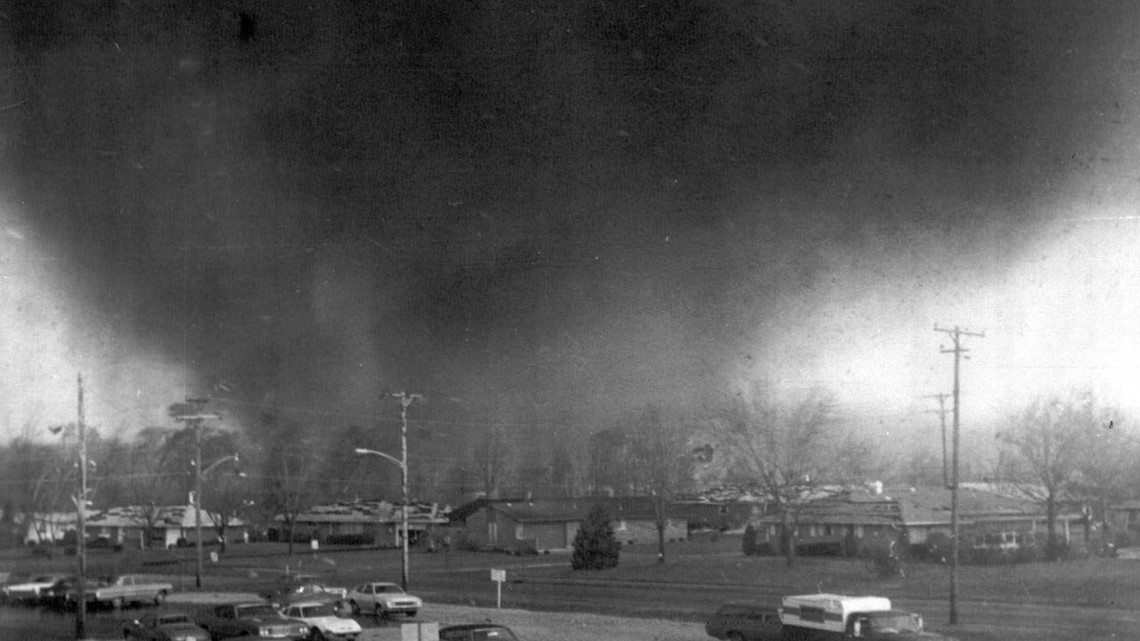
It wasn't just Kentucky that saw damage from the super outbreak. Several tornadoes touched down in southern Indiana as well. Two tornadoes formed near Madison, Ind., hitting nearby Hanover College which had to close for a few weeks.
Near DePauw in Harrison County, the National Weather Service (NWS) said an EF-5 tornado killed six people. It also cut through Palmyra and into the Borden area.
The deadliest of the super outbreak tornadoes hit the town of Xenia, Ohio. The EF-5 tornado killed 32 people, injured more than 1,000 others and caused an estimated $100 million in damages.
Between Kentucky and Indiana, 126 people died and at least 2,145 people were injured.
When the severe storms finally subsided, a total of 335 people were killed, more than 6,000 people were injured and thousands more were left homeless.

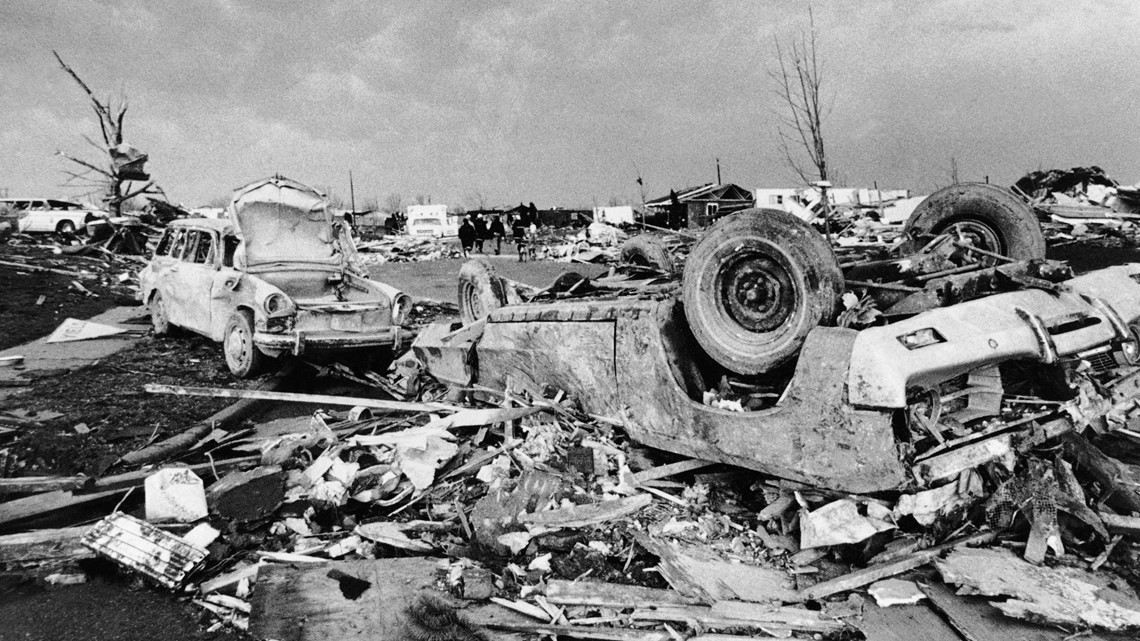
Closer to home: How the 1974 tornado outbreak impacted Louisville
Louisville was one of the areas hit by the 1974 tornado outbreak, particularly in the Crescent Hill neighborhood. Wadia Newman, from nearby Indian Hills, shared how she and her family survived.
"That's all you think about is 'We made it,'" Newman said.


Newman was just 14 years old on April 3, 1974, when a tornado tore through her neighborhood in the suburbs of Louisville.
"I was home, it was a sunny day and I remember it being very windy," Newman said.
The young teenager was playing the piano when she realized her life was in danger.
"Well my mother got more frantic and she said get in the basement," Newman said. "So I went upstairs and lifted the blinds up and came face-to-face with a tornado."
Newman and her family lived on top of the hill at the end of Comanche Trail in the Indian Hills neighborhood, giving her a clear view of the massive twister headed right for their home.
"I looked up at the sky right above our house and the clouds were spiraling into the tornado and at that point that's going to be a direct hit," Newman said.

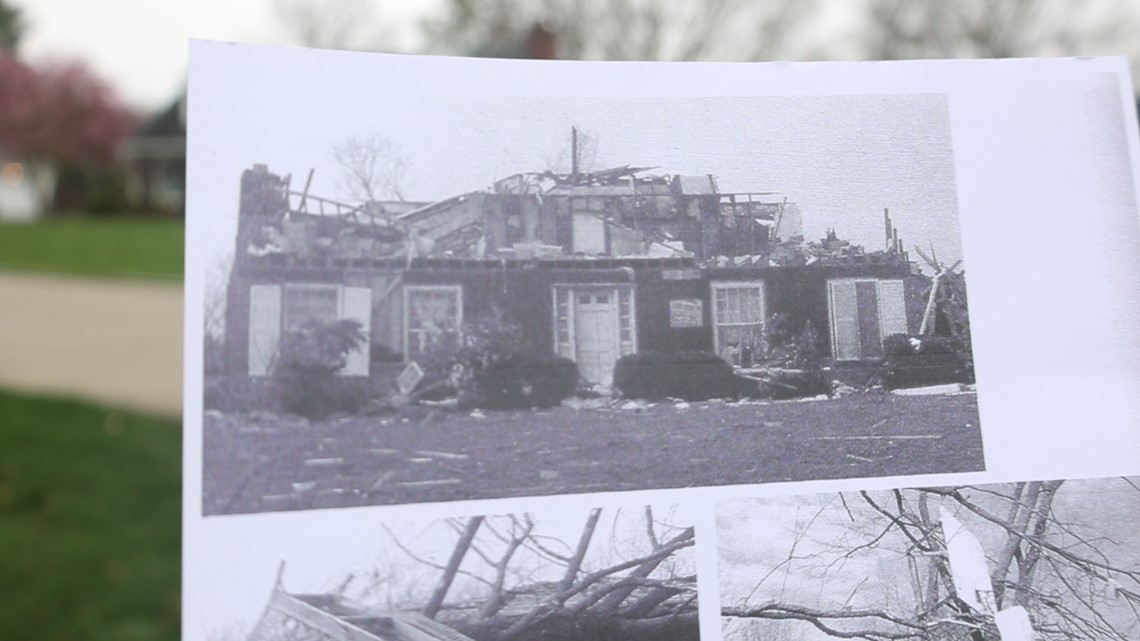
The 14-year-old grabbed her sister, Peggy, and ran down the stairs into the basement. The girls and their mother huddled in a corner.
Newman said all they could hear was their own breathing before everything went dark.
Newman said she heard a strange tone surrounding them that started quiet but gradually became the highest pitch imaginable.
"When it hit that top note, everything blew apart," she said. "The glass shattered, the lights went out, I saw tree branches going by and it just laid right on top of us."
In that moment, Newman said she "absolutely" thought she was going to die.
Then it finally stopped.
"When it started to move away, I was in disbelief," Newman said.
As a young Wadia, Peggy and their mother walked up the stairs from their basement, they got their first look at the devastation. Their garage was gone, one of their neighbors were injured and nearly every home on the street was damaged or destroyed.
"It went up our street and just pulverized all the houses," Newman said. "Pretty much everybody lost everything they had."
This street holds many incredible survival stories, including, a man hunkering down in a treehouse while he weathered the storm and a pregnant woman whose life was saved thanks to her basement. That woman's baby will celebrate her 50th birthday this year.

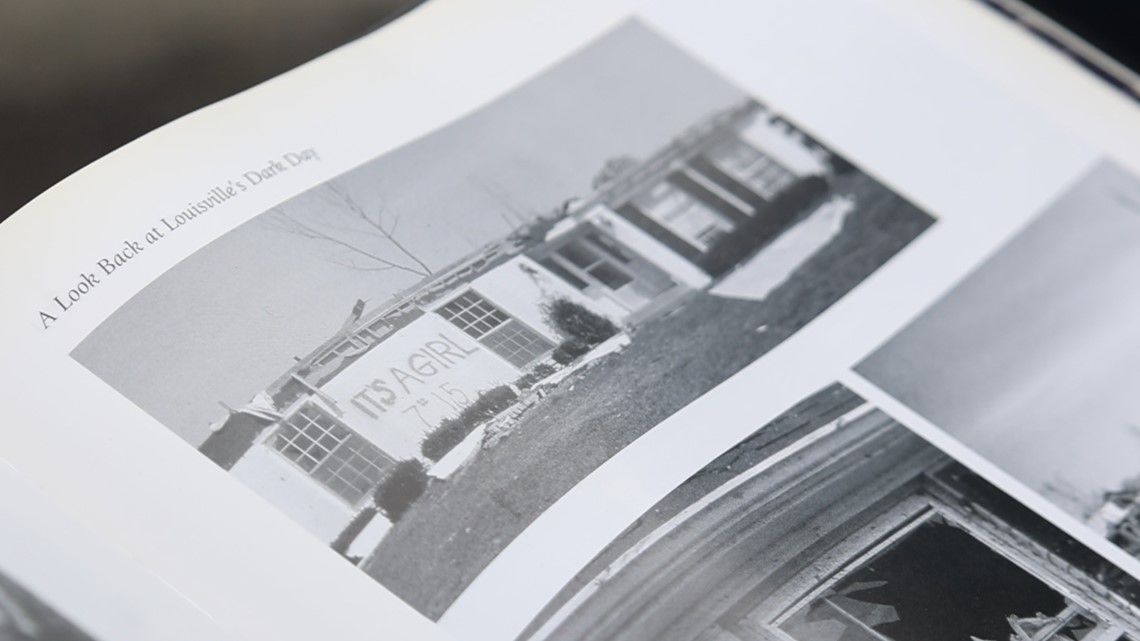
Every house on the street was affected by the tornado. Some houses were completely gone, with only rubble left.
In the middle of the destruction, however, Newton found her piano right where she left it. The sheet music was untouched.
"It was open to a page called 'Blow Wind," Newton said.
The tornado picked up Newton's family home and moved it four inches. The house had to be torn down and rebuilt, a project that would later inspire her future career.
"We ended up finishing ourselves because we were over budget, so we ended up doing a lot of the work: drywalling, staining – I'm an architect now," Newton said.

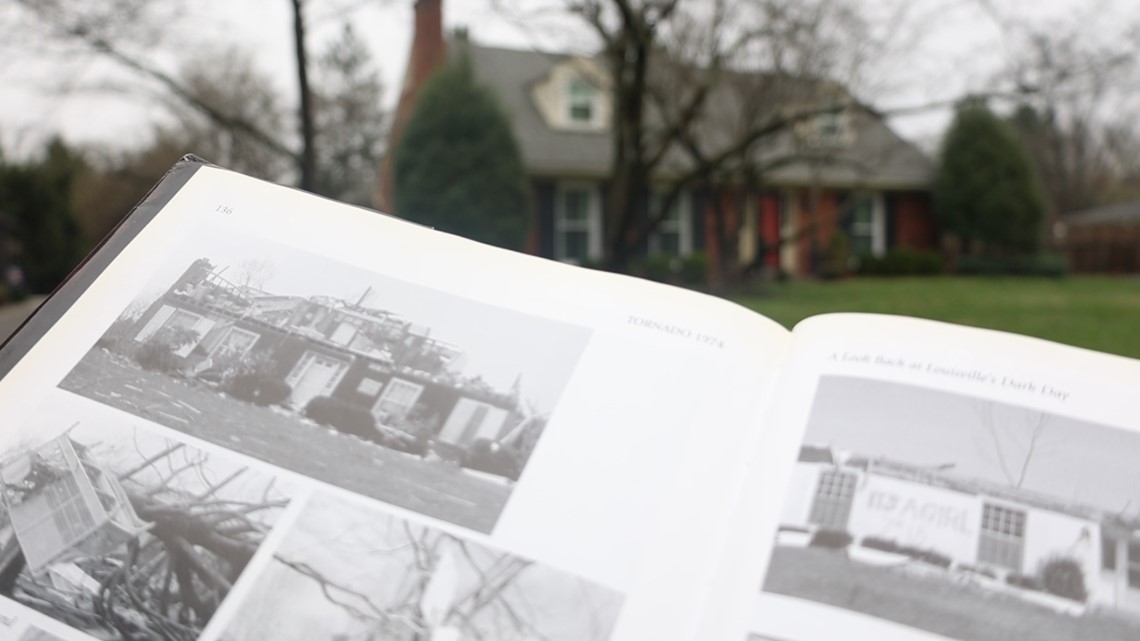
Her nightmares faded with time and despite the unpleasant memories, Newton ended up living on this street for 55 years.
Newman sold the house 10 years ago. This interview was her first time revisiting since the sale.
Although the tornado forever changed this street, she said the house looked great and she felt joy being back.
"When you go through something as traumatic as this and you come out with your life, that's all that matters and every day is a blessing," Newman said.
The cost of the tornado was $37 million for Louisville, which equals close to $250 million today.
'Our main objective was to save people's lives' | How news has changed since the 1974 tornados
News coverage was very different in 1974, with mobile live units not around in Louisville at the time.
Back then, it was film and live radio coverage. WHAS-TV and radio had the biggest broadcast staff in Kentucky all under one roof on April 3. One of the broadcasters on the air that day for hours was Byron Crawford. He had been on the job barely a year as a news anchor.
"It's unbelievable to me that it's been 50 years. I just can't believe it," Crawford said. "It doesn't seem like that long ago to me. I was 28 years old then."
Now 78 years old, Crawford reflects on what it was like to work for WHAS-TV and radio on such an unforgettable day.


"It was not one of these picture-book tornadoes with the tail whipping back and forth," he recalled. "This was a big cloud looming."
In the air that day was the WHAS traffic copter manned by Louisville native and veteran pilot Dick Gilbert. Gilbert was telling listeners in real time about where the tornado already hit and where it was headed next.
Gilbert followed the tornado for 11 miles northeast across Louisville. The tornado impacted Audubon Park, the Highlands, Crescent Hill, Indian Hills and Northfield.
He was also the first to report on the damage left behind. 900 homes were leveled or severely damaged and 400 acres of Seneca and Cherokee Parks lost 2,000 trees. The cleanup included planting 2,500 new trees.
"He was up there watching this thing and we were listening to it spellbound," Crawford said.
Crawford remembers one live report like it was yesterday. It was a time when people turned to AM radio during emergencies. WHAS-TV and radio never lost power, and Crawford was on the air reporting for nine hours.
"A woman in southern Kentucky told me about watching her house lift off its foundation and she said you could look up and see the furniture suspended in the rooms just floating," Crawford said while waving his arms. "The whole house was still together. [It] hadn't exploded yet."
"We knew that our main objective was to save people's lives," he added.
Louisvillians knew things were bad when the water company was hit.
"It was the wildest thing because people were saying, 'Don't use the water.' They were saying to cut back on the water," Crawford said.
In 2008, Kentucky Hall of Fame journalist Ken Rowland told WHAS11's Doug Proffitt the water company damage sent a dire message.
"It was a serious situation, but we were all affected together," Rowland said.
The two journalism professionals worked at the same station, with one on TV and the other down the hall in radio. In the end, they came to the same conclusion after the tornado cleared.
"It's strange that a storm that literally tried to blow us apart brought us together," Rowland said.
Strongest Kentucky tornado: Meade County still feels affects of storm 50 years later
The tornado that hit Brandenburg and Meade County was the strongest to hit Kentucky on April 5.
"The sun shines brightly on Brandenburg today, but it was a very dark day 50 years ago," Bill Morgan said.
Thirty-one people in Brandenburg lost their lives to one of the deadliest tornadoes to ever touch down in the Bluegrass State. Today, a memorial stands to immortalize those who died.

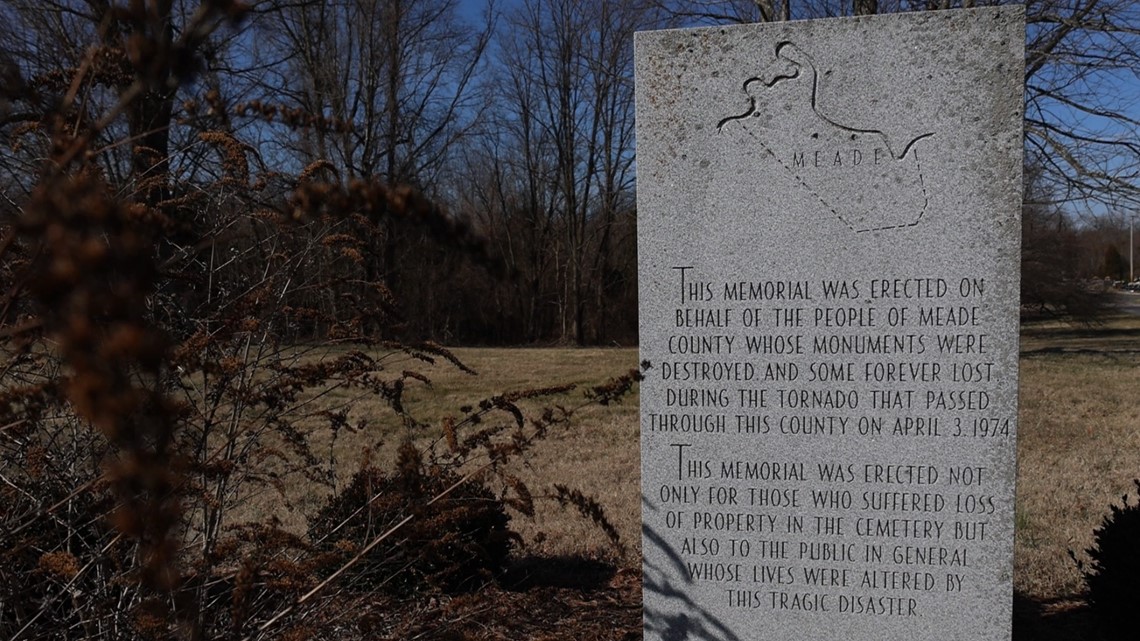
On the day of the tornado outbreak, Morgan said he knew something wasn't right.
"The whole day was different. Something was wrong. It felt wrong. It felt pressure. The smell was wrong. Everything about that day was wrong," Morgan said.
His suspicions were correct because everything about that day ended up being disastrous.
Morgan was with his friend, current Brandenburg Mayor David Pace, when he saw what he calls a "wall of black" heading straight towards them.
He didn't know it at the time, but it was Kentucky's first – and to this day only – F5 tornado.
Morgan, Pace and a few other friends broke down the basement door of Brandenburg's old City Hall to take cover.

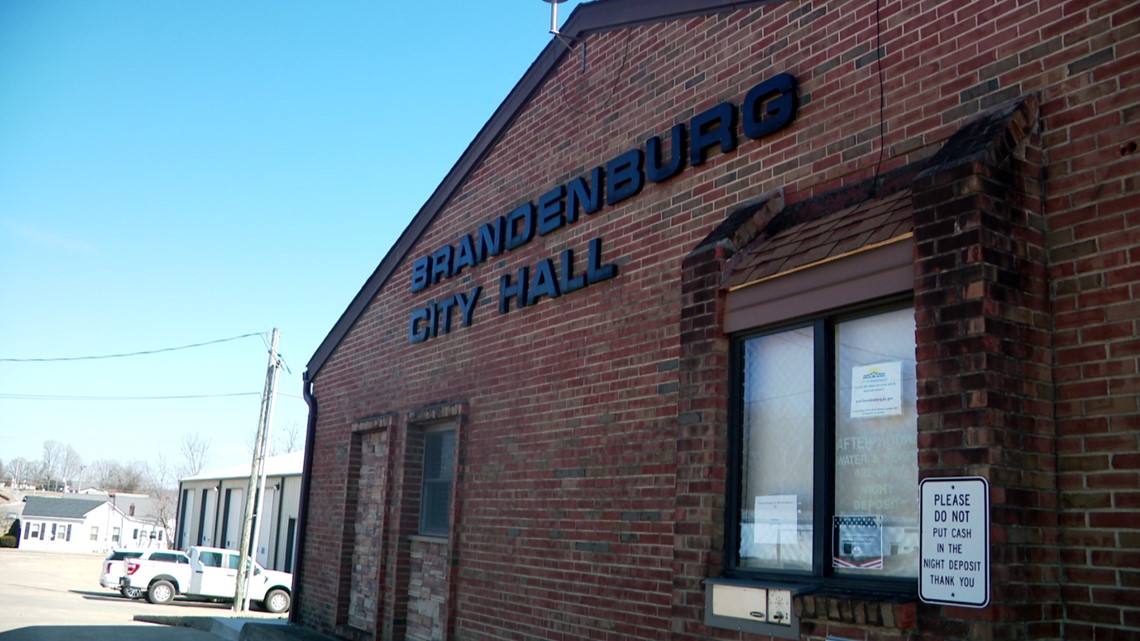
"We were in a totally dark room. Tripping over fire hydrants, water pipes, fire hoses, trying to get to the to the back wall," Morgan said. "If we had been over on that side of the street, we may not be here talking about it."
The sound that came with the tornado was deafening. The roaring, massive tornado shook City Hall – at the time an old two-story house – twisting it off its foundation.
After the tornado passed, Mayor Pace said another sound that was equally as terrifying came. Silence.
"The first thing I noticed is how calm and quiet it was," Pace said. "And then the noise of people screaming and crying, and people walking down the streets, you know, injured."

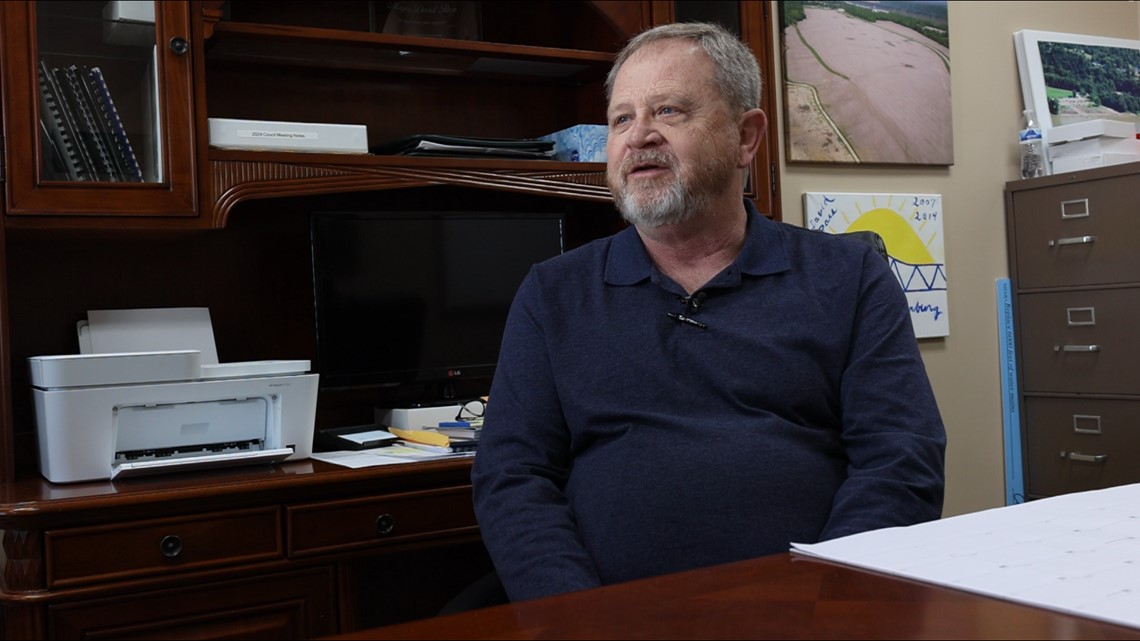
The Brandenburg Mayor described a chaotic scene. There were injured and deceased people strewn across town. Helicopters from Fort Knox were landing in a small baseball field to help.
Among the dead was a mother and her three children.
Among the survivors, a 90-year-old and her son-in-law. They were sucked out of their shelter and carried by the tornado 200 yards away.
From afar, the wounds left behind by the tornado have largely been healed. But Morgan and Mayor Pace say they remember the destruction vividly.

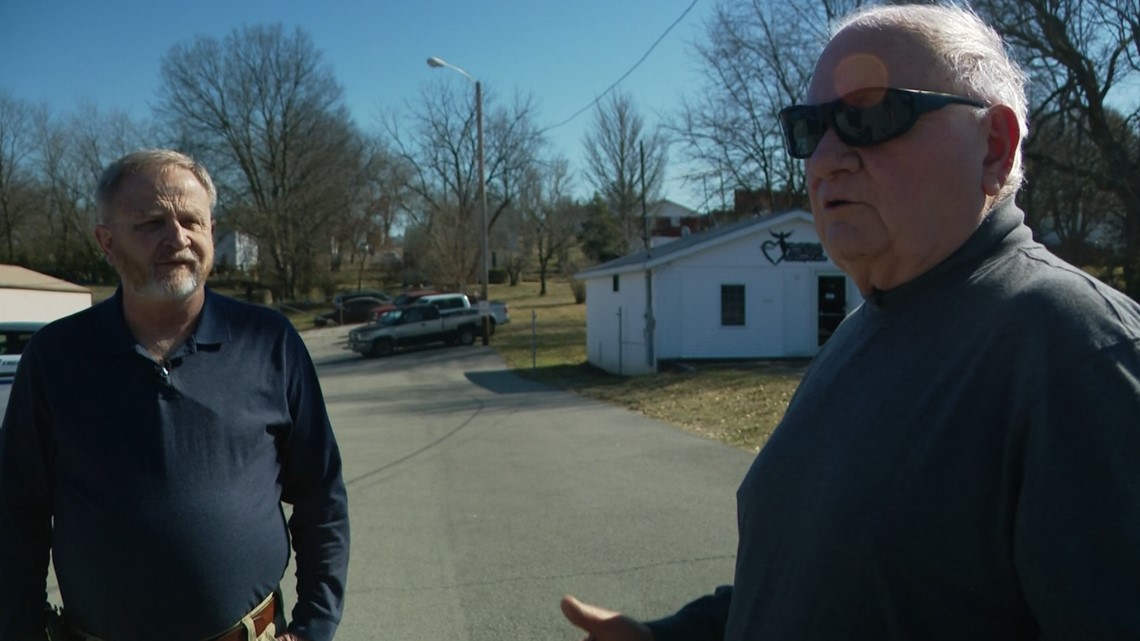
"All of that side of the street, everything that you see now was gone. Everything was gone," Morgan said. "There's neighborhoods behind those buildings that are gone and have never been built back."
Anytime Kentucky experiences a strong tornado, like the EF-4 tornado that ripped through Mayfield back in December 2021, Mayor Pace and Morgan are brought back to what they experienced 50 years ago, something that's also difficult for those who didn't live through Brandenburg's disaster to understand.
"You feel for those folks, what they got to go through, because it's a lasting effect," Pace said. "My coworkers at the power company, they just couldn't understand. Especially younger ones that weren't even born. It's had an effect on my life for forever."
Though some buildings never returned, the community did. It was one of few positives that emerged from the disaster. Pace and Morgan said their friendship especially strengthened after the tornado.
Many in Brandenburg came to have a better respect of severe weather because of the tornado. The disaster even encouraged them to build stronger, more durable buildings.
Community, comradery and support flourished after the devastation, and better emergency infrastructure in the form of EMS and fire response were built.
"The rally of this community to make its comeback...I mean, it would have been easy for this town to have suffered for many years, but it didn't happen. Everybody worked hard to make it become what it is today and even stronger," Mayor Pace said.
'Dinosaur age' | Weather technology evolves with time
The outbreak changed the way people looked at not only the world, but weather as a whole.
Radar today is our primary severe weather tracking tool, but in 1974 radar technology was just in its infancy. The maps were difficult to read in a dark room, with no doppler effect to detect storm motion or tornado rotation.
"We couldn't make much judgement other than [the tornadoes] were there and this particular echo had hit Hardinsburg and Brandenburg and was in a line to come here, "NWS Chief Meteorologist Dave Reeves said in 1984. "I asked them to sound the sirens and told them we were putting out a tornado warning. Turns out, it was 17 or 18 or 19 minutes later that the tornado touched down here."
As the leader of Kentucky and southern Indiana's NWS office, meteorologist John Gordon called it the "dinosaur age of meteorological technology."

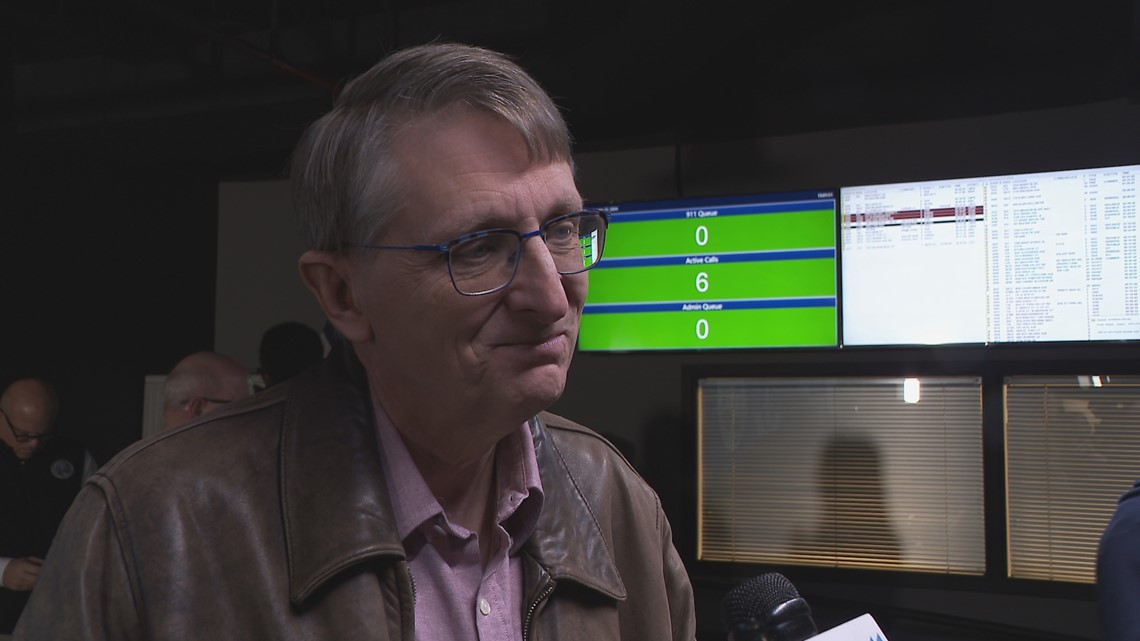
Gordon said they had one model before 1974 and no radar.
"Now, we have dopplers, we have webcams, we have mesonets, we have more meteorology programs," he said.
After the outbreak, the mission was clear — better technology equals better forecasting, which equals better warnings.
NWS installed the new WSR-74 radar in 1978, which could look up into a storm. However, the big leap in radar tracking technology wouldn't arrive until 1994 with the WSR-88 radar. It's the same radar used to this day at Fort Knox.
"You can look at any given target and which way it's moving to from or whatever horizontal vertical data. We can look at the amount of ice in the storm [and] how much hail," Gordon said.
Tornado warning lead time has increased from just a few minutes in 1974 to now 15-30 minutes.


In addition to better tools, we also needed meteorologists. After the outbreak, TV stations started hiring trained meteorologists to interpret and forecast the weather rather than simply relaying information from NWS.
More meteorologists meant more schools teaching meteorology.
"You had 15-18 schools in '74. Now, we're up to 90," Gordon said. "They weren't teaching the deep understanding of thunderstorm processes that we do now in school."
It was time to improve predictions and WHAS11 did that with the station's first Chief Meteorologist Chuck Taylor.
Through new generations of scientists, and breakthroughs in technology, the impact of the tornado outbreak is still felt today, and is ultimately saving lives.
Make it easy to keep up-to-date with more stories like this. Download the WHAS11 News app now. For Apple or Android users.
Have a news tip? Email assign@whas11.com, visit our Facebook page or Twitter feed.
Make it easy to keep up-to-date with more stories like this. Download the WHAS11 News app now. For Apple or Android users.
Have a news tip? Email assign@whas11.com, visit our Facebook page or Twitter feed.

